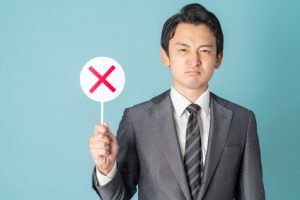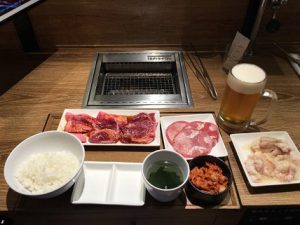It is said that the productivity of Japanese companies is lower than that of non-Japanese companies. In fact, the companies and organizations I’ve worked for have had wasteful or inefficient operations. Three of the most commonly cited wasteful things are
(1) Meetings
(2) HANKO Culture
(3) Face to face sales
So, in this newsletter, let’s examine whether or not these will be changed by the coronavirus.
(1) Meetings
The main characteristics of a useless meeting are
“I have to attend a meeting that has nothing to do with my work.”
“It ends with just a sharing of information.”
“We got together to talk about it, but it didn’t come to a decision.”
But these are separate issues from working remotely, so even if the meeting held online, it won’t change much if the purpose of the meeting and the way to work doesn’t change.
(2) HANKO Culture
Not a few people say they want to work remotely, but have to come to the office to stamp documents. “The HANKO Culture is a major cause of the difficulty of working remotely,” some said. In June, the Japanese government announced that “a seal on a contract is not necessarily required. (FYI, it wasn’t originally required by Japanese law to put a seal on the contract, but the government announced it because many people misunderstood.)
Now there’s a greater awareness that other means of authentication, such as electronic authentication, are acceptable. So while many people think the HANKO Culture will change, I expect it to be about halfway there. The reason for this is that there are system costs associated with implementing alternative methods such as electronic authentication. However, 99.7% of Japanese companies are small and medium-sized enterprises (SMEs), and many of them cannot afford to invest in systems, so they continue to do things the way they used to. First, large companies that can afford it will be the first to adopt e-authentication. Second, it will be popular in companies that do business with such large companies. So I think it will take some time.
(3) Face to face sales
At the company I used to work for, we had a tradition of visiting clients at the end of the year to present them with calendars made by our company. I knew that it was useless to give them a calendar because it wouldn’t affect our work, and that we could just mail it instead of visiting, but I followed the previous custom.
But nowadays, most companies refrain from meeting with outsiders as much as possible. This is a good excuse to stop wasting time on face-to-face sales if the client side is willing to STOP. And since older people, who used to be reluctant to do online meetings, are now using ZOOM and the like, there will be less face-to-face sales and more business meetings over the phone and online.
These are my predictions. What do you think??
Forty-four people died on July 4, 2020 due to the heavy rains that fell mainly in the Kyushu region. The damage is especially severe in Kumamoto Prefecture. Fourteen people died at a nursing home in Kuma Village.
Recently, it is not uncommon to see the heaviest rainfall in recorded history, probably due to extreme weather conditions. In addition, there are rivers all over Japan, so there is a risk of flooding all over the country. Japan is about to enter the typhoon season, so this is a good time to take precautions to prevent flooding in your area. It is strongly recommended that you check your flood risk.
The risk of flooding can be checked on the hazard maps operated by Japan’s Ministry of Land, Infrastructure, Transport and Tourism.
This site will provide you with information on “flood risk,” “landslide risk,” and “tsunami risk” for your area. Just open the map and hover over your area to see how much of the above risk you are at.
And the accuracy of this hazard map is said to be extremely high.
Flooding in Nagano Prefecture, caused by a large typhoon in October 2019, has also been shown to have a high flood risk. And the floods that occurred in Kumamoto this time were also shown as dangerous on the hazard map.
The red point on the Google map on the left is where the nursing home where 14 people died is located. And the image on the right is a hazard map showing the flood risk at the same location. The area where the nursing home is located is pink, indicating the possibility of 10-20 meters of flooding.
And this image also shows a Google map on the left and a hazard map on the right. You can see that there are many places near Tokyo that are at high risk of flooding.
(The blue point on the right is the location of the flooding in Ibaraki Prefecture in 2015, which was also marked as high risk.).
We urge you to check out the hazard map to save yourself and your family’s lives.
With an indirect method, the learner receives explanations using an intermediate language (such as his or her native language) so that he or she can understand.
With a direct method, the learner receives explanations in Japanese only.
If your native language is English, you may worry about whether it’s better to temporarily get explanations in English or to get explanations in Japanese. In this article, I will explain the pros and cons of both methods.
Indirect Method – Pros
-Explanations are definitely easier to understand.
-Learners can understand in a short amount of time.
Indirect Method – Cons
– It’s easy for learners to develop a habit of always thinking in their native language.
-It’s hard for learners to develop a habit of reasoning based on the Japanese they know.
-There may be many instances of not understanding when having an actual conversation in Japanese.
Direct Method – Pros
-Learners will develop a habit of reasoning based on words they do know even if there are words they do not understand.
-Lessons can be taken in a form that closely resembles an actual conversation in Japanese.
Direct Method – Cons
– Learners will sometimes misunderstand.
-It may take a while before the learner can understand.
The indirect method is less stressful because beginners cannot understand explanations in Japanese. However, the advantage of studying using the direct method from the beginning is that learners are better prepared for a real conversation because they have been listening to actual conversations in Japanese only. In other words, the difference is whether you consider speaking only in Japanese as “stressful” or “good training.”
I recommend the following approach for people who want to become used to Japanese as quickly as possible, but who also want to use their lesson time efficiently.
・First, tell your instructor ahead of time not to use an intermediate language unless you request otherwise, and basically use Japanese only.
・Then, ask your instructor for explanations in an intermediate language only when you can’t understand no matter how hard you try.
However, make an agreement with your instructor not to use an intermediate language more than three times per lesson.
(It doesn’t matter if you agree to five times or ten times, it’s just seems best to use an intermediate language as little as possible.)
・Then, do not use an intermediate language more than the agreed number of times no matter how frustrating it becomes.
I recommend this approach because, by sticking to these rules, you will develop a habit of thinking for yourself as much as possible even when you don’t understand and you can enjoy your lessons like a game.
8 points to make your trip to Japan more fun
May 16, 2020
It’s difficult to travel right now, but when the coronavirus is over, I hope that many people will enjoy their trip to Japan. In this article, we’ll introduce eight points to help you plan your trip to Japan and make it even more fun.
First of all, there are five points to make a plan for your trip to Japan.
- Decide on a theme for your trip.
- decide on a budget and number of days
- Decide where you want to go.
- make a list of things you want to do
- try to make a real schedule
Let’s take a closer look. The order of 1 to 4 may be back and forth. You may have to rework your plan a few times, but it’s still a process of making a better plan, so enjoy it.
- Decide on a theme for your trip.
If you’re new to Japan or have never traveled to Japan before, you can use “Tokyo and Osaka” as a theme for the cities you want to visit. If you are a repeater, for example, you may want to have a specific theme such as “I want to compare delicious sushi,” “I want to go to many hot springs,” or “I want to take a good looking photo for Instagram. Once you’ve listed a few, think about those priorities.
- decide on a budget and number of days
Deciding on a budget and number of days is a necessary step to make it a realistic plan.
- Decide where you want to go.
It’s normal to want to go to as many places as possible. Decide where you can realistically go with your purpose, budget and days.
- make a list of things you want to do
Decide specifically where and what you want to do and make a list. If there are too many to list, consider those priorities as well.
- try to make a real schedule
Find out where to stay, how to get there, how long it will take, and how long it will take to do the things you want to do. In Japan, trains and planes often go as planned, but make sure you have plenty of time on your schedule.
These are the basic points.
Next, I’ll give you three tips to make your trip to Japan more enjoyable.
6.Look up not only on the web but also in guidebooks.
Research can be done on the web, but it can be time consuming to look up each site one by one. So I buy a guidebook that allows me to look up information efficiently. Looking through guidebooks with my family and thinking, “Oh, I want to go to this store too! The price is also cheap at around 1,000 yen per book.
FYI, “Rurubu” and “Mappuru” are the most famous guidebooks in Japan. Both are designed for Japanese people traveling in Japan, so there is only a Japanese version, but it has detailed information on it. There are a lot of photos, so even those who are not confident in their Japanese will find it helpful.
Rurubu Tokyo https://amzn.to/2WlcdDU
Rurubu Osaka https://amzn.to/35SP8vt
Rurubu Hokkaido https://amzn.to/3bjnvwE
Rurubu Okinawa https://amzn.to/3cvfYwk
7.Ask a travel planning professional.
If you’re not good at planning or don’t have the time for it, you might want to hire a travel planning professional. COCONALA is a site that deals with the skill sharing economy business and there are also people who can help you plan your trip.
https://coconala.com/services/45520?waad=twyeQ5fH
This person will make a plan for 2 nights and 3 days for 1,500 yen anywhere in Japan.
https://coconala.com/services/45883?waad=twyeQ5fH
This person will plan a trip to Hokkaido for 3 nights and 4 days for 3,000 yen.
8.Make an album after the trip.
When we travel abroad, we make an album for each trip. Photo data taken with a digital camera or mobile phone is a rare opportunity for the whole family to look back at it. It’s a great way to keep an album to enjoy your family’s time together and memories of your trip.
If you are a Japanese language learner, try to look up information in Japanese as much as possible.Talking to your Japanese teacher about your travel plans will be a good practice for you too!
5 Recommended Japanese Gourmet Online Shopping Sites!
March 16, 2020
Many people are looking forward to eating delicious food in Japan. However, as the coronavirus is rampant (as of March 10, 2020 at the time of writing this article), gourmet travel is difficult. Here are some ways to enjoy delicious meals from all over Japan without going out.
Have you ever heard the word ”お取り寄せ(otoriyose)”? The act of obtaining a product from another location when there is no product you want to buy at the store is the origin of the word ”お取り寄せ(otoriyose)”. The word ”取り寄せ(toriyose)” is a noun form of ”取り寄せる(toriyoseru)”, and “お(o)” has been added to the top to say it more elegantly, and the word ”お取り寄せ(otoriyose)” has come to be used more often. And now, it is increasingly used in the sense of “purchasing popular groceries online.”
Here are five popular Japanese Gourmet Online Shopping Sites
dancyu.com
Operated by the popular gourmet magazine “dancyu”.
Otona no shumatsu otoriyose club
Operated by the popular gourmet magazine “Otona no shumatsu”.
FUJINGAHO no otoriyose
https://fujingaho.ringbell.co.jp/shop/
Operated by women’s magazine “FUJINGAHO”.
“dancyu.com” and “Otona no shumatsu otoriyose club” are a little for male, but this one is a little for female. There are many sweets.
47CLUB
Main products are local specialties, specialty products, and local gourmet.
Local newspapers in each region carefully select and introduce delicious products from 47 prefectures in Japan.
Nippon no takaramono (Japan’s treasure)
https://www.ecshop.undiscovered.jp/
Most of the producers are small businesses, so mass production is not possible, but the products on this site are all highly valued.
Although the number of products is small compared to other sites, it is recommended for those who want to find hidden local specialties.
Rakuten
https://event.rakuten.co.jp/food/area/
Rakuten is the largest e-commerce company in Japan.
Popular products from all over the country are gathered widely.
Every site is full of delicious dishes and ingredients, and it will be fun just to look at it.
Please enjoy delicious Japanese foods by “otoriyose”.
More people use camper vans when traveling in Japan!?
January 17, 2020
Where do you stay when traveling in Japan? I think that many people stay at hotels and inns, but recently it more and more people rent camper vans.

If you are traveling to Japan for the first time, you will most likely choose the so-called golden route: Tokyo, Mt. Fuji, Kyoto, Osaka. However, many repeaters want to go to places other than the Golden Route, especially the countryside in Japan, and people who are not satisfied with ordinary tours often use a camper van.
Therefore, this time I will write about traveling in Japan using a camper van that is becoming a popular new travel style.
?
Benefits of traveling in Japan using a camper van
(1) good cost performance
Normally, hotels and inns in Japan have a price per person. On the other hand, camping cars are set at the price per car. Therefore, as the number of users increases, the price per person decreases. In addition, transportation costs can be reduced by dividing gasoline and highway charges by all passengers.
(2) 3 or more people can stay together
There are not many rooms where 3 or more adults can stay in Japanese hotels. If it is a camper, there are many cars that four adults can stay with.
(3) Free travel plan
Trains and buses have a fixed schedule of operation, but you can create a free travel plan if you are a camper. In addition, you will be able to go to places where trains and buses cannot. Tours are only available in popular places. You can also go to your special places that other foreign travelers can not go to.
?
Recommended service for people traveling to Japan using a camper van
I’ve checked companies that have a good explanation of foreign languages, so I’ll introduce them to you.
(1) Camper van rental : Japan Campingcar Rental Center
https://www.facebook.com/japanrv/
(2) Camper van sharing service : CarStay
https://www.facebook.com/carstay55
Points to note when traveling to Japan using a camper van
A convenient and cost effective camper trip, but there are some caveats.
(1) Driving qualification
Driving a car in Japan naturally requires a valid driver’s license in Japan.
The requirements vary by country, so check this site.
https://www.nipponrentacar.co.jp/english/user-guide/driverslicense.html
(2) different traffic rules
There may be traffic rules different from your country, so please enjoy safe driving so that there are no accidents or troubles. Japan is on the left. Please note that the highways running in the center of the city(Tokyo, Osaka, Nagoya, etc.) have many exits and entrances so that even Japanese people get lost.
(3) Car size
Campers are bigger than ordinary cars, and the height is high, so the stability is poor. Therefore, be careful because contact accidents and rollover accidents occur more easily than other vehicles. There are many narrow roads in Japan.
(4) Spots where you can stay in the car are limited
There are not many RV parks where you can stay in a car like in the US. In recent years, the number of people who occupy a parking lot for a long time while staying in a car has increased, and there have been cases where trouble has occurred. When planning your travel plan, look for places where you can stay in the car. The CarStay site mentioned above introduces good spots.
If you are bored on a regular trip, why not try this new style?
I hope your trip to Japan will be fun.
Job popularity ranking is not useful
December 18, 2019

If you work in Japan, what are the criteria for choosing a company?
When you find a job in Japan, you will see the “Job popularity ranking, but frankly, this ranking is not useful, so in this article, I will explain why and will introduce some other rankings.
Reason 1: The respondents are college students who has just started job hunting.
Companies that make such rankings often take questionnaires to university students who come to joint company briefings. For this reason, the number of companies that respondents know and the actual situation of the companies are extremely limited. It’s like asking a zero-beginner Japanese learner about recommended business Japanese materials.
Reason 2: The reality is just name recognition ranking
This is related to the first reason, most of the top ranking companies are doing BtoC business rather than BtoB. There are many excellent BtoB companies in Japan, but such companies are not well known, so they do not appear in the ranking.
So what ranking should you refer to instead?
Here are some suggestions.
Suggestion1:Job change popularity ranking
Example : https://doda.jp/guide/popular/
The respondents are already working, and the question is “Which company is better if you change jobs?”, That will be closer to the actual evaluation of the company than to ask students.
Suggestion2:Average annual income ranking
Example : https://toyokeizai.net/articles/-/257530
Many people think salary is the most important. For those people, the average annual income ranking of employees will be helpful.
Suggestion3:Lifetime wage ranking
Example : https://toyokeizai.net/articles/-/310498
In Japan, where the lifetime employment system was strong, there are many people who place importance on the ranking of lifetime wages rather than annual income.
Suggestion4:Ranking of employees working overseas
Example : https://toyokeizai.net/articles/-/206216
There are many people who are worried about whether they can return to their home country in the future, work at a place where they can use their language skills, or do business globally. This is a ranking that allows you to know how many people work for the company overseas.
The operating profit margin ranking and overseas sales ratio ranking may also be helpful for you.
However, such ranking varies depending on the industry and business model, and may vary depending on the time of aggregation. For this reason, it is better to think that there is no ranking that perfectly meets your requirements.
So what should we do?

If you have a specific industry or job type that you want to work with, it may be good to create your own ranking based on that industry or job type. Also, if you are concerned about both the average annual income ranking and ranking of employees working overseas, it may? be good to create a list of companies that are ranked in both.
In this article, I wrote about how to use rankings, but it is always recommended to consult with people who are already working in the industry you want to go to without using such rankings.
Our free video course called “Japanese for Job Hunting” is available on YouTube.
I would be happy if you could register for your channel or do a GOOD evaluation 🙂
https://www.youtube.com/channel/UCZtUc_wd7BOKT9BvhRjyvsg/featured
I hope you all succeed in getting a job or changing jobs.
“What are the recommended textbooks?”
This is the most difficult question I ever be asked to answer.

The criteria for choosing textbooks varies depending on Japanese learning history, learning goals, learning style, learning environment, budget, and preferences.
So, what factors should be considered in choosing textbooks?? In this edition, we summarized tips for choosing textbooks.
(1) Do not trust Amazon Reviews
I often shop on Amazon and always check for customer reviews before buying a product.
However, customer reviews on Amazon are not trustworthy when choosing textbooks, because there are few reviews considering the factors mentioned above. As for different learners, it has to be taken into account each learning environment, budgets, and so on, but no customer reviews consider them.
Also, there are regional differences in the evaluation of customer satisfaction.
For example, the customer evaluation for the “Japanese for Busy People I: Kana Version (Revised 3rd Edition)” that we often use in lessons for beginners are as below.
(Information as of 10/11/2019)
————————————————-
Country /Stars out of 5/Number of reviews
————————————————-
Japan / 3.5 / 14
US / 4.1 / 85
UK / 4.4 / 100
CA / 4.3 / 19
————————————————
Even with the same product, you can see the 0.9 points difference between Japan and UK.

(2) There are only a few textbooks stocked in general bookstores.
When I go abroad, I go to a large bookstore in the area and check what kind of textbooks are sold. Since there are only a small number of Japanese learners overseas, Japanese textbooks do not contribute much to the sales of bookstores. Therefore, there are only a few textbooks are stocked.
(3) Don’t trust an advice of any bookstore clerks
A general bookstore clerks will never know about learning Japanese so that you can not expect the advice of the store clerk. They might tell you the most popular textbooks, however, the best-selling textbooks are not necessarily the best textbooks for you.
(4) Don’t trust the advice of ordinary Japanese people as well
If you have Japanese friends, you may ask them for advice. However, ordinary Japanese do not know about Japanese language education for foreigners at all. They don’t even know what textbooks are available for learning Japanese.

For the above reasons, choosing textbooks is not so simple. So, what will be reliable sources on choosing textbook?
Here are some sources on people and sites helpful for your decision.
(1) Professional Japanese teacher
Professional Japanese teacher will most likely give you the best answer. However, of course, there are both amateurs and professionals. To give you a good advice on recommended textbooks, teachers need to have a deep understanding of many textbooks, but some teachers have used only a few. Which advice is more reliable by teachers who have experienced only one textbook or one have used 100? Ask how many books the teacher has experienced before.? You will be able to trust an advice of a teacher who has use at least 10 books, preferably 20 books.

(2) Special shop in Japanese language teaching and studying materials
If you can buy textbooks in Japan, you can go to a special shop in Japanese language teaching and studying materials and check them.
Here are some links to special shops in Japanese language.
Bonjinsha http://www.bonjinsha.com/
Japanese Bookstore Sogakusha http://www.sogakusha.co.jp/
Japanese Books Online http://books-online.jp/

(3) Friends who are fluent in Japanese
If you have friends who have already reached your ideal Japanese level, their opinions may be helpful for you. Especially friends of the same native language of you will be reliable. However, it is important to understand that the person does not know much of the Japanese teaching material, but only gives advice to you based on his/her limited experience.
(4) Japanese language School curriculum
If any of the above is difficult to find, the textbook used at the Japanese language school may become a tips for you. Japanese language schools usually have courses by level and learning purpose, so check the textbooks close to your level and purpose. Recommended learning materials for each course are also listed on the J-OS website. If you are interested, please refer to the following page.
For English
General Japanese Course>
https://j-os.com/en/courses/generalcourse/
JLPT Preparation Course>
https://j-os.com/en/courses/jltpprepcourse/
Business Japanese Course>
https://j-os.com/en/courses/businesscourse/
For Japanese
General Japanese Course>
https://j-os.com/ja/courses/generalcourse/
JLPT Preparation Course>
https://j-os.com/ja/courses/jltpprepcourse/
Business Japanese Course>
https://j-os.com/ja/courses/businesscourse/
* The main users of J-OS are English-speaking people or English-speaking business persons. Therefore, please note that the information may not be suitable for non-English speaking people and students.
What did you think about these tips?
Whether or not you can find a good textbook is an important factor of successful Japanese learning.
Is it awkward eating at Yakiniku restaurant alone?
July 16, 2019

When I go home late at work, I sometimes drink alone in a standing bar near my office and then go home. I personally don’t care about solo dining, however, there are people who can’t afford eating alone because of family traditions, or it’s awkwardness.
What kinds of opinions are there about solo dining in your country?
Nowadays in Japan, a growing number of people are eating alone and it is increasingly considered socially accepted.
Recently, “Gusto”, one of the major family restaurants, has enhanced the table for one person.
As you can see from the photo below, the solo dining space in Gusto provides the environment especially for work and study unlike the other normal seats.

The features are as follows.
- Power supply and Wi-Fi are available
- Completely private space
- Enough space for both a laptop and for dining
The other day I have used the space between the meetings and it was very comfortable.
Fast food restaurants like McDonald’s and Yoshinoya have had many solo diners before, but it is a recent change that the number of solo diners has increased besides fast food restaurants.
Originally “famiresu” is an abbreviation for family restaurant, so main target user are family. However, the recent trend is that more people use the place alone.
In addition, “Ikinari Steak” the stand-up steakhouse or “Yakiniku Like” where solo diner can enjoy yakiniku alone, are also getting popular in Japan.
Although the “Ikinari steak” has opened its first overseas in New York, it seems to be struggling.
The food service business is greatly influenced by the food culture of the country, so just because it is popular in Japan does not necessarily mean it is popular overseas.
For example, “Yoshinoya” in China where most users are family unit provide various menus like a family restaurant, not a beef bowl specialty restaurant like in Japan.
If you have an opportunity to come to Japan, why don’t you try eating out alone? Even if you go with more than one person, you will usually be sitting next to each other, so please enjoy a new experience in Japan.

In Japan, there are two major ways to do Karaoke:
(1) at a Karaoke Box:
You are assigned your own room for you and your party to enjoy. It is a good option to enjoy karaoke with your friends or fellow workers.
(2) at a Karaoke Snack Bar:
It is a small individually-owned bar that usually has a single Karaoke machine, so you need to share a karaoke machine with other guests.
About Karaoke Snack Bars, please refer to the following article for details. (Only Japanese)
https://loohcs.jp/articles/293
At a Karaoke box, your party can enjoy karaoke on your own ways, however, at the karaoke snack bar, you need to be careful to choose songs depending on the atmosphere and the other customers. In such bars, it is not so “cool” to sing only anime songs or songs popular among young generation.
In this edition, I will introduce a selection of famous Japanese songs that make you special.
There are 10 songs for each male and female singer.
All songs are very popular among 50’s to 60’s Japanese, that melody is not so quick and lyrics are simply understandable.
If you go to karaoke with senior Japanese business people and sing a few these songs, you will be no doubt to be considered “you are so SHIBUI(You have really good taste)!”
■ Songs by male singers
Natsu no owari no harmony (Yoosui Inoue / Kooji Tamaki)
This song is covered by many singers and known to people of a wide range of ages.
Https://www.youtube.com/watch?v=WCSeiSOaHxY
Mata au hi made (Kiyohiko Ozaki)
https://www.youtube.com/watch?v=5NVcDuS_hxM
Hajimari wa itsu mo ame (ASKA)
https://www.youtube.com/watch?v=74IKR0WeKXY
Nani mo ienakute …natsu (JAY WALK)
https://www.youtube.com/watch?v=ZkoQPOhhu38
Sake to namida to otoko to onna (Eigo Kawashima)
https://www.youtube.com/watch?v=tjrPAAiCbuA
HERO (Kai Band)
There are many songs with the same title. Please search on the “Kai band.”
https://www.youtube.com/watch?v=ZVU3BVmxxU8
Azusa 2 goo (Kariudo)
https://www.youtube.com/watch?v=OCK-nWaYxJE
Saigo no ame (Yasushi Nakanishi)
https://www.youtube.com/watch?v=JmmPzK0chqU
Kowarekake no Radio (Hideaki Tokunaga)
https://www.youtube.com/watch?v=C7QVaahn44A
Kanashii iro yane (Masaki Ueda)
Those who speak Kansai dialect should master this song!
https://www.youtube.com/watch?v=xQeEOoKhIqg
■ Songs by female singers
Ito (Miyuki Nakajima)
This is a very popular song at weddings.
I couldn’t find the original video, so I will introduce other singers are singing instead.
https://www.youtube.com/watch?v=DboG2xszmcE
This video that amateur singing at a wedding is also popular.
https://www.youtube.com/watch?v=aXwIawYfkjgs://www.youtube.com/watch?v=aXwIawYfkjg
Amagi goe (Sayuri Ishikawa)
https://www.youtube.com/watch?v=yvc0LadtZuk
Love is Over (Ouyang Fei Fei)
https://www.youtube.com/watch?v=zzRsmDHmZJI
Kawa no nagare no yooni (Hibari Misora)
Hibari Misora is called a “Diva of Shoowa.”
https://www.youtube.com/watch?v=d_Ns_B23LT0
Ano kane o narasu nowa anata (Akiko Wada)
https://www.youtube.com/watch?v=mdLydN0liYQ
Toki no nagare ni mi o makase (Teresa Teng)
https://www.youtube.com/watch?v=oJY2RtLADkM
Mata kimi ni koishiteru (Fuyumi Sakamoto / Billie Bang Bang)
This song was originally a male duo “Billie Bang Bang”, but it became more famous with the cover of Enka singer “Fuyumi Sakamoto.”
https://www.youtube.com/watch?v=SBTjDVLmHn8
Miserarete (Judy Ongg)
https://www.youtube.com/watch?v=OFNW0IZUdto
Koi ni ochite (Akiko Kobayashi)
https://www.youtube.com/watch?v=7lTkywZljmk
Olivia o kikinagara (Anri)
https://www.youtube.com/watch?v=TgRQP9C1M4s
Nagori yuki (Iruka)
https://www.youtube.com/watch?v=tp9qHeMjiKg
You can easily find the lyrics of any song by searching for the keywords “song title & lyric”.
It will be a good study of Japanese to find your favorite song and remember the lyrics.
So why don’t you try to sing your favorite Japanese songs in Japanese, whether you are good at singing or not good at singing?
Categories
Recent Posts
- I cannot keep up with meetings conducted in Japanese. Are there any good ways to study?
- Are there any good writing materials for business Japanese? (Three keys to developing business Japanese writing skills.)
- Are there any free materials available for studying business Japanese reading?
- Should I read newspapers for reading practice in business Japanese?
- Are there any good business magazines to practice reading business Japanese?
Archives
- August 2022
- June 2022
- May 2022
- April 2022
- March 2022
- February 2022
- January 2022
- October 2021
- January 2021
- August 2020
- July 2020
- June 2020
- May 2020
- April 2020
- March 2020
- February 2020
- January 2020
- December 2019
- November 2019
- October 2019
- September 2019
- August 2019
- July 2019
- June 2019
- May 2019
- April 2019
- March 2019
- February 2019
- January 2019
- December 2018
- November 2018
- October 2018
- September 2018
- August 2018
- July 2018
- June 2018
- May 2018
- April 2018
- March 2018
- February 2018
- January 2018
- November 2017
- October 2017
- July 2017
